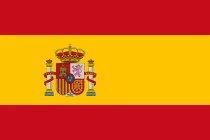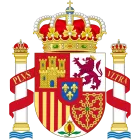Spain

Geographical Location of Spain
Spain is the fourth largest country in Europe; the country borders on Portugal in the west and France and Andorra in the northeast. Spain is one of the most mountainous countries in Europe. Both the Iberian mountain range in the northeast and the Sierra Nevada in the southeast have peaks over 3,000 m above sea level. In the northwest of the country you will find the slightly lower Cantabrian Mountains. Large rivers flow around mountain ranges. In the center of the country lies the largest highland plateau in Europe, almost treeless, with poor soil and a harsh climate. Along the coast, both north and south, you will find fertile plains.
Large differences in altitude create large variations in the country's climate. The northern coast has a typical Atlantic climate, while the southern regions of the country are much warmer. The central hinterland can experience temperatures of up to 40 degrees Celsius in summer and is significantly colder in winter than the rest of the country.
In 2002, Spain experienced a serious environmental crisis when a tanker sank about 210 kilometers off the coast of the Spanish region of Galicia. The ship was loaded with several thousand tons of heavy oil, causing serious damage to the coasts of Spain, Portugal and France. Other environmental problems include soil erosion and frequent fires during the summer months, which threaten vast areas of the country's forests. For this reason, the authorities began large-scale tree planting. In addition, the country's cities are struggling with high levels of air pollution.
Brief History of Spain
The Iberian Peninsula has been inhabited by various peoples since 16,000 BC, including the Phoenicians, Carthaginians and Romans. When the Caliphate of Baghdad conquered the peninsula in the eighth century, Arab Spain emerged as the cultural, scientific and economic center of southern Europe. Several monuments still stand as testament to this time.
However, in northern Spain, small Christian kingdoms resisted the Arabs. Towards the end of the 15th century, Spain was united as an independent kingdom for the first time. When Christopher Columbus traveled to South and Central America and claimed the areas he reached as Spanish territory, Spain quickly became the most powerful country in Europe. Spain remained a great power until the 19th century, when it began to lose control of its colonies.
After years of economic problems and dictatorship, a bloody civil war broke out in Spain in 1936. There, the forces of fascist Francisco Franco took control of the country, establishing a new dictatorship that lasted until his death in 1975. After Franco's death, the country quickly developed a functioning democracy. After the 80s, a number of new social reforms were introduced and Spain also became an important part of European cooperation and, among other things, joined NATO in 1982 and the EU in 1985.
Society and Politics of Spain
Spain is a constitutional monarchy where the king has minimal power. Executive power belongs to the prime minister, who is elected in democratic elections. In the decades following Franco's rule, the moderate right-wing Popular Party and the Socialist Party were the most important parties in the country. Both parties sought the political center and were willing to compromise to achieve political results. Spain is struggling with great corruption among politicians holding high social positions. Politicians and businessmen of both parties have recently been convicted of embezzlement and bribery.
Spanish politics is characterized by tensions between the central government and the country's 17 regions, with the Basque Country and Catalonia in particular given considerable internal autonomy through their elected assemblies. Some regions have their own police and their own customs regulations. Disagreements between the government in the capital Madrid and the separatist movement in the Catalonia region have become a complex and important political issue.
Economy and Trade of Spain
From a poor agricultural country in the early 1980s, Spain has transformed into a country with a strong industry and a large service sector. Tourism has been particularly important, and in 2018 Spain was the country in the world with the most tourists. Within the country there are large differences between poor and rich areas. In the Madrid area and further north towards the Atlantic coast, more people are employed and wages are higher than in the southern regions. With a strong economy, Spain was a founding member of the European Monetary Union in 1999.
Spain was hit hard by the 2008 global economic crisis and unemployment rose sharply. At the beginning of 2013, unemployment was over 26 percent, one of the highest rates in Europe. Since 2014, the Spanish economy has gradually become stronger again. The country continues to struggle with high unemployment, especially among young people. There are especially many young people in the private sector, such as the service sector and the construction industry, who find it difficult to find work. This is a serious social problem, and the coronavirus pandemic has made it worse.
Spanish Cuisine and Culinary Traditions of Spain
The geographical location of Spain has greatly influenced the recipes of Spanish cuisine. Spain is washed by the sea and ocean on almost all sides, which has introduced many types of fish and seafood into the assortment of Spanish cuisine. https://kashevar.com/en/recipes/spain Spain itself is divided into several provinces, each of which has its own culinary traditions and its own set of traditional Spanish dishes. Spain produces large quantities of oranges, olives and grapes, which are used in many Spanish recipes. Many Spanish dishes and drinks are widely known - the cold gazpacho soup, the sangria drink or the piperade dish. Another difference between Spanish cuisine is the presence of small snacks - tapos, which are prepared from a wide variety of products. Tapos recipes can include meats, fish, cheeses, sausages, seafood, eggs, vegetables and much more. In general, Spanish dishes can serve as a good illustration of the culinary traditions of Mediterranean cuisine.







